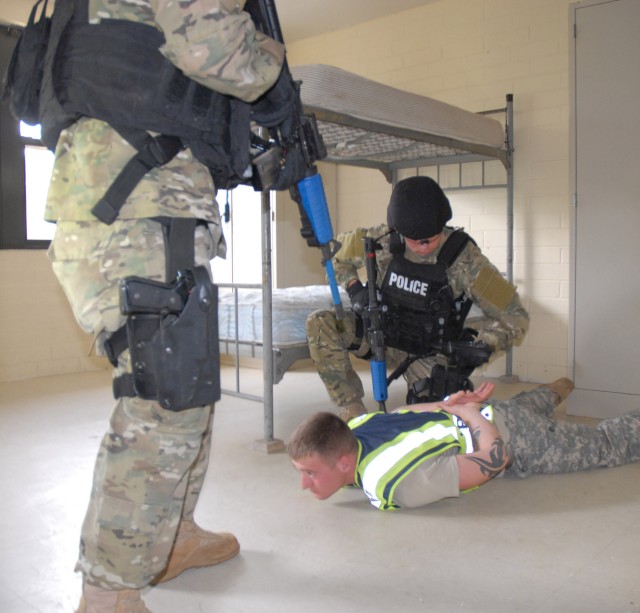FORT RUCKER, Ala. -- Most people think it will never happen to them, or where they work, live or go to school.
Up until they found themselves staring down the barrel of a killer's gun, most of the victims of the Columbine High School, Virginia Tech University and Fort Hood, Texas, massacres probably thought the same thing.
Waiting until the shooting starts to think about what you should do is too late, advises Maj. Jay Massey, Fort Rucker deputy provost marshal.
While there is no evidence or indications that Fort Rucker is more at risk than any other place for what the Department of Homeland Security calls an active shooter situation, there are things people should do if they ever find themselves caught up in a crisis like the ones mentioned above.
"All active shooter scenarios are different. Some are very well planned out, targeted and executed. Others are more random and spur of the moment," Massey said. "In most cases, the gunmen have access to the buildings where the killings occurred and they were in confined spaces. Training cannot prepare everyone for every situation, but it may help in the event something like this happens."
Unfortunately, shootings have occurred at various other installations throughout the U.S. since the Fort Hood incident, according to Rollie Edwards, Directorate of Plans, Training, Mobilization and Security Plans, Operations and Mobilization Division chief.
"Since the Fort Hood tragedy, a shooting occurred at Fort Bliss, Texas, and an armed intruder/hostage situation occurred at the Fort Stewart, Ga., hospital," Edwards said. "One of the most important things each of us can do is ensure we are prepared to respond - both individually and organizationally - if an event occurs here."
The most important thing to do, of course, is survive, Massey said.
"Because active shooter situations are often over quickly, individuals must be prepared both mentally and physically to deal with such a situation," he said.
Prevention, security and planning ahead are all things people can do to increase their chances to survive well before an active shooter situation erupts around them, according to a Homeland Security pamphlet on what to do during an active shooter situation.
Prevention - Be sensitive to those around you. Take appropriate action and seek help if you need it.
Security - Comply with and help ensure security measures are met.
Plan ahead - Rehearse and know in advance what you might do, but remain flexible and do what you have to do to stay alive.
But how do people survive' Of course, it all depends on the circumstances, but Homeland Security has three easy-to-remember "do's" in order of precedence: evacuate, hide out and take action against the shooter.
Evacuate
If there is a way to do it, evacuate the area. Be sure to:
* Have an escape route and plan in mind. Hopefully you've rehearsed this and have some alternate routes in mind.
* Evacuate even if other people decide not to follow, and make sure you evacuate well away from where the shooting is taking place.
* Leave your belongings behind.
* Help others escape if possible.
* Prevent other people from going into the area where the shooting is taking place.
* Keep your hands visible.
* Follow the instructions of any police or security guards you encounter.
* Don't try to move injured people. This can be a tough decision, but think about what your capabilities are - do you really know what to do to help them'
* Call 911 when you are safe.
Hide out
If you can't evacuate, then it is time to find a place to hide where the shooter is less likely to find you. Hiding places should:
* Be out of the shooter's view.
* Provide protection if shots are fired in your direction, like behind large items like cabinets or desks.
* Not trap you or restrict your options for movement. It is OK to break something to get away.
* When hiding, remember to be quiet - including turning off cell phones and other sources of noise.
* People should lock doors that will lock and blockade the doors with heavy furniture. And remember, walls don't make for substantial cover.
Take action
If all else fails and your life is imminent danger, it is time to take action against the shooter by:
* Acting as aggressively as possible against the perpetrator.
* Throwing items and improvising weapons, such as fire extinguishers, books, magazines, letter openers, knives, pens, briefcases, mop or broom handles, bottles, shoes, boots - whatever might work.
* Yelling.
* When people act against the shooter, they need to commit to their actions. They should follow through and fight violently until they can safely escape or the shooter is incapacitated. They are fighting for their lives and even if they are injured they should stay in the fight.
(Editor's note: Russell Sellers, Army Flier Staff Writer, contributed to this article.)


Social Sharing